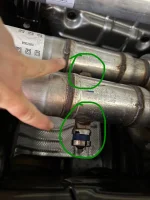- Joined
- Feb 11, 2025
- Messages
- 31
- Media
- 1
- Reaction score
- 23
- Location
- Beaver Ohio
- Military
- US ARMY Vietnam Era
- Current Ride
- 2025 Ram Tungsten Crew 29A Package H.O. Air Suspension, 22 inch Wheels, Retrax Power Cover
- Current Ride #2
- 2021 Hellcat Charger
On a Hellcat you can wire the flaps to stay open while the exhaust is cold before you start it. Will not get any codes, and you do not have to change your exhaust. I'm sure you would be able to do the same on the exhaust of the RHO. Look for the box on the exhaust and that's it! You will see what I'm talking about once you follow it. It will not hurt anything, can change it back when you want.










